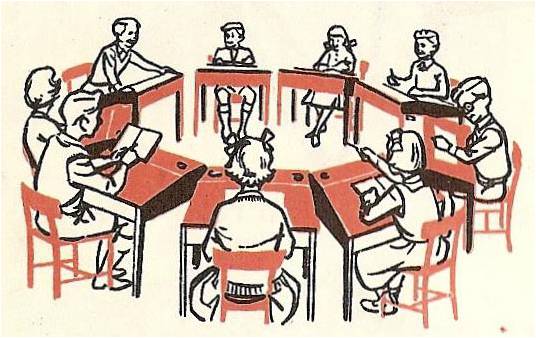* This was originally posted on my old blog on 3rd June 2017.
Dogme ELT is a teaching philosophy started by a group of teachers who considered that there seemed to be an over-reliance on materials in current language teaching (Thornbury, 2006, p. 72). This discussion started when Thornbury was inspired by the filmmaker Lars von Trier who proposed a cinema without the use of special effects and props (Dogme 95 movement). In his article, (Thornbury, 2000) he questions the quantity of coursebooks and resources and wonders if there is real communication and focus on 'the inner life of the student' in these materials. He also mentions that ELT has become grammar-obsessed, often forgetting about the real use of the language. Then, he outlines some principles for this new philosophy, which would be refined later on in his and Meddings' Teaching Unplugged book.
The three key principles for a Dogme (Meddings & Thornbury, 2009, p.8) lesson are:
- It is conversation-driven;
- It is materials-light;
- It focuses on emergent language.
 |
| Image via Thornbury's Blog |
Conversation is a big part of Dogme ELT in the sense that ‘the direction of the lesson is determined by what emerges in conversation between the teacher and the learners’ (Wright, J. & Rebuffet-Broadus, 2013, p.117). Therefore, the teacher has the role of a facilitator, helping learners reformulate and express their ideas clearly and also as a language advisor, when he draws attention to relevant points of the language. This idea of fluency coming first comes from the Task-Based approach, which is something that perpetrates the beliefs of Dogme. It also draws on the idea of communication as the ‘exchange and negotiation of meaningful messages’ (Meddings & Thornbury, 2009, p.9) from the Communicative Approach. However, Dogme goes beyond that view as conversation should be about ‘the people in the room’ in order to be really meaningful for the learners.
According to Meddings and Thornbury (2001b), being materials-light does not necessarily mean that coursebooks would not be allowed in the classroom, but they should not dictate or distract from the main learning opportunities of the lesson. They believe that materials should encourage dialogic learning, which means that ‘both teachers and pupils make substantial and significant contributions and through which pupils’ thinking on a given idea or theme is helped to move forward’ (Mercer, 2003, p.76, as cited in Wright, J. & Rebuffet-Broadus, 2013, p.126). This means that materials should be locally generated and always be of interest to the learners, as this way it would make learning more likely to take place.
The last of the three key principles is the focus on emergent language, which has to do with dealing with the language that emerges in the conversation process. Dogme views the learners’ language as both process and product of instruction (Meddings, L. & Thornbury, S., 2001b, p.43). It draws on the Communicative Approach’s notion of a learner-centered curriculum where the focus was more on the process of communication than on the product (i.e. the knowledge of language). However, it adds on to it when it gets the learner’s grammar from the activities and turns it into the courses’ grammar itself. It has the learners as being agents in their own learning process, as they will determine their learning experience (Meddings & Thornbury, 2009, p.18).
The question that remains is ‘How do we make a lesson from the material we receive?’ (Meddings, L. & Thornbury, S., 2001b, p.41). Once the conversation has started and the language has emerged, the teacher is basically free to choose from the techniques available. For instance, he can choose to focus on form, by putting learners errors on the board and conducting a debate on why the errors were made and how to correct them. The teacher can also record parts of the conversation and conduct text reconstruction activities followed by role play of an improved version of the same dialogue. In short, the teacher has at his disposal the same techniques available from the traditional training courses. As the authors point out, the important thing is to capture text in any form and put it to work ‘by improving it, rehearsing it, performing it, re-formulating it in another mode or register’ (Ibid, p.43) and also focus on language, both the weaknesses and the strengths. In the end, there should be some kind of rounding-off activity, in order to reflect on what happened in the lesson and discuss the possibilities for the future.
Thornbury actually confesses that ‘there is nothing very original in Dogme’ (Thornbury, 2005, p.3 as cited in Wright, J. & Rebuffet-Broadus, 2013, p.71). It brings ideas from the communicative approach, humanistic education, critical pedagogy and other materials-light approaches, which mean that many teachers who follow the Dogme principles, actually only incorporate some of these aspects to their teaching.
______________
References
Books
Freire, P. 1968 Pedagogy of the Oppressed Penguin
Meddings, L. & Thornbury, S. 2009 Teaching Unplugged: Dogme in English Language Teaching Delta Publishing
Thornbury, S 2006 An A-Z of ELT Macmillan
Wright, J. & Rebuffet-Broadus, C. 2013 Experimental Practice in ELT: Walk on the Wild Side The Round Publications
Articles
Meddings, L. & Thornbury, S. 2001 'Dogme and the coursebook'
http://thornburyscott.com/tu/MET3coursebook.htm (12.11.13)
Meddings, L. & Thornbury, S. 2001 'Using the raw materials: A Dogme approach to teaching language' MET vol 10, no 4, 2001
Meddings, L. & Thornbury, S. 2002 'Using a coursebook the Dogme way: Making sure it's the dog that wags the tail' MET vol 11, no 1, 2002
Meddings, L. & Thornbury, S. 2003 'Dogme still able to divide ELT'
http://www.theguardian.com/education/2003/apr/17/tefl.lukemeddings (11.11.13)
Nield, D. 2005 'Spirit of Dogme' English Teaching Professional, Issue 41, Nov 2005
Thornbury, S. 2000 'A Dogma for EFL' IATEFL Issues, 153, 2.







0 comments